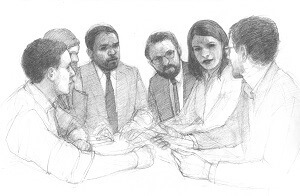Together, Not the Same: Strength in Diversity and Collaboration
Rock, Paper, Scissors
On Oscar night 2016, diversity was not only the hot topic on main stage and social media, but charmingly presented in a commercial for Android’s Be together. Not the same. marketing campaign. The “Rock, Paper, Scissors” ad spot, with its evocative use of the St. Elmo’s Fire (Man in Motion) theme song and friendly anti-bullying message, offered a simple reminder of what we can do when we stop competing with one another and use our diversity to help each other out.
While nonprofit collaboration has traditionally been viewed as an opportunity for like organizations to come together to reduce duplicative services and administration, there’s increasing recognition of the power of collaboration among diverse players — across different disciplines as well as across sectors — to advance social change. Granted, bringing together organizations with differing worldviews can be very challenging, but it can also result in real strength.
As consultants, we welcome the opportunities we have to help organizations come to appreciate this diversity and to understand how marshalling their differences behind a shared goal can create greater impact. Sometimes, this can occur through a temporary collaborative relationship or more integrated alliance. Other times, it means creating a single, unified organization that is able to achieve more powerful results than any of the partners could have attained on their own, as in the example below.
A New Jewish Day School Organization
Earlier this year, five of North America’s leading Jewish day school organizations announced a transformative new partnership. Their decision to form an integrated organization brings diverse perspectives under one roof, consolidating partners’ collective strength without seeking to homogenize the Jewish day school experience.
The participating organizations include:
- Day Schools of Reform Judaism (PARDES)
- The Partnership for Excellence in Jewish Education (PEJE)
- RAVSAK (The Jewish Community Day School Network)
- The Schechter Day School Network (Schechter)
- Yeshiva University School Partnership (YUSP)
These five players represent a range of orthodox, conservative, reform, and community day school/pluralistic constituencies. Part of the strength in their merging is in bringing together these different perspectives on Judaism and Jewish education as a way to enhance services to schools of different denominations.
For more than two decades, denominational intermediaries have evolved to assist Jewish day schools in areas such as teaching, leadership, governance, affordability, and school finances. While supporting the unique needs of each denomination, they have diluted the impact of Jewish day school education on community cohesiveness. Studies have shown that fewer Jews are active in local Jewish communities, as evidenced by reduced program participation, membership, and/or charitable giving — and these challenges are particularly acute among younger people.
Jewish day school education is key to increasing engagement in the Jewish community by:
- Connecting young people and their families to Jewish values and other Jews
- Strengthening connection to Jewish heritage, culture, and identity
- Educating new and future leaders for the Jewish community
- Helping young people develop beliefs and skills to actively participate in Jewish life.
However, diverse approaches to Judaism raise the question of how best to revitalize Jewish day school education to achieve these outcomes. Recognizing that marshaling resources across denominations creates one path to a more cohesive community, the AVI CHAI Foundation — a leading funder of Jewish day schools — played an active role in fostering the exploration and negotiation process leading to this merger.
Participants engaged in a thoughtful 12-month planning process guided by La Piana Consulting, which involved heads of schools, lay leaders, funders, and other partners in creating a vision and structure for the new organization. Expected to launch in July 2016, the new organization (as yet unnamed) will not only serve more than 375 schools and nearly 100,000 students, but will honor diversity in togetherness — identifying and delivering those services and activities that cut across different affiliations as well as those that may be denomination- or affiliation-specific.
Before this merger, schools were limited by what they were offered as members or affiliates of one or two intermediary organizations. Now they will have access to an expanded set of comprehensive, leading-edge programs, services, and networking opportunities. And by pooling the talent, expertise, and resources that were originally dispersed among its founding agencies, the new organization will be better positioned to revitalize the field, creating the foundation for a more cohesive — yet diverse —Jewish community.
Finding the strength in diversity, through collaboration, can be a long, challenging, and sometimes painful, process — but in the end, the results are often better for everyone.

Senior Managers Scott Cotenoff and Heather Gowdy have both been closely involved with the Jewish day schools merger and co-contributed to this post.


Comment section